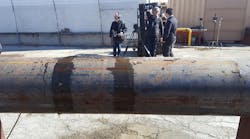Smithsonian History Channel program on critical infrastructure – need to coordinate control system safety limits with piping changes
February 20, 2018 I participated in taping of a Smithsonian History Channel program on Hidden American History at Berkeley Engineering and Research. The program is due for showing the summer of 2018. The original purpose of the taping was to address the 1982 Gazprom pipeline explosion. However, the scope was modified to focus more on the 2010 San Bruno natural pipeline rupture because it was more relevant to current technology. Consequently, the purpose of this taping was to film the destruction of a 10inch diameter steel pipe typically used in natural gas distribution and other pipeline applications (the bulge in the picture is where the pipe split open). This pipe was smaller, but with similar characteristics, to the 30inch transmission pipe involved in the San Bruno natural gas pipeline rupture. I was invited to participate because of the cyber security issues associated with pipeline safety. One of the interesting items that occurred was that piping integrity can change over time which can affect control system safety limits. However, control system safety limits often do not change. The San Bruno natural gas pipeline rupture was an example where a pipe failed before the pipe pressure reached the control system safety limits. Because of the requirements for the use of remote, automated shut-off valves that came from the San Bruno natural gas pipeline rupture, cyber security becomes a more important issue. Cyber security is also an issue for natural gas pipelines because of the Aurora vulnerability that can damage natural gas compressor stations.
Joe Weiss





